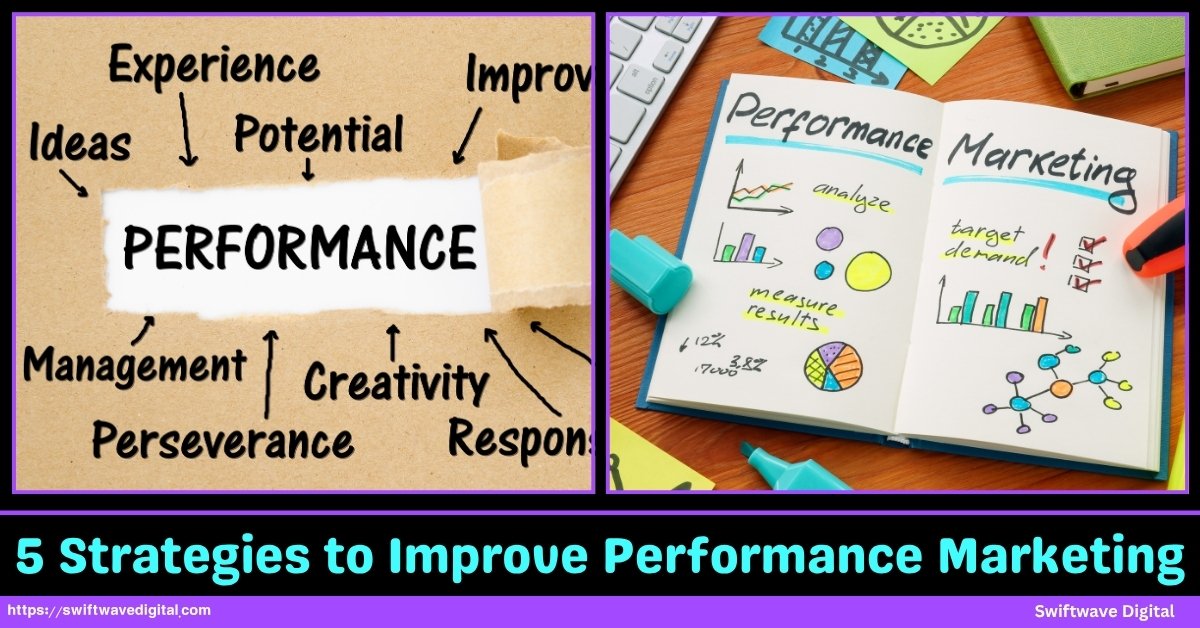Performance Marketing is the backbone of modern digital advertising — a results-driven approach where every click, impression, and conversion counts.
Unlike traditional marketing that focuses on awareness, performance marketing thrives on measurable outcomes: ROI, lead generation, and customer acquisition.
It gives businesses the power to track exactly where their budget goes and what return they’re getting in real time.
However, achieving consistent results requires more than just running ads it demands strategy, optimization, and data-driven decision-making.
From audience segmentation to smart scaling, the real game lies in fine-tuning every stage of the funnel to boost efficiency and profitability.
5 Strategies to Improve Performance Marketing
In this guide, we will explain five proven strategies to improve your performance marketing and maximize return on every ad dollar spent.

1. Audience Segmentation
The foundation of performance marketing is understanding your audience. You can’t sell effectively if you don’t know who you’re talking to. Most campaigns fail because they target too broadly.
Instead of marketing to “everyone,” divide your audience into smaller, specific segments based on who they are and how they behave.
Start with basic demographics like age, gender, and location, but don’t stop there. Dive deeper into their interests, purchase intent, and browsing behavior.
Use tools like Meta Ads Manager, Google Analytics, or TikTok Ads to gather insights about who engages with your content and what actions they take.
Create separate audience groups for each stage of the funnel awareness, consideration, and conversion.
Once your segments are defined, craft different messages for each one. A person seeing your brand for the first time shouldn’t get the same ad as someone who has already visited your website or added a product to their cart.
Adjust your creative and call-to-action according to their intent level. This ensures relevance, reduces wasted impressions, and improves conversion rates.
Effective segmentation helps you focus your ad spend where it matters most. When you stop talking to everyone, you start reaching the right people — and that’s when performance marketing becomes truly efficient.
2. Ad Creative Testing
The ad creative is the first thing your audience sees — and it’s often the deciding factor in whether they engage or scroll past. The key is not to assume what will work.
You need to test every element of your ad systematically. Performance marketing thrives on structured testing, not random design changes or creative hunches.
Start by identifying what to test. Break down your ad into components — headline, image or video, body text, and call-to-action. Choose one variable at a time to test so you can isolate what truly impacts performance.
For example, test two headlines with the same image to see which drives more clicks, or test two visuals with the same headline to measure engagement.
Let your tests run long enough to gather meaningful data. Avoid making decisions too early; ads need enough impressions and clicks to reach statistical reliability. Use the built-in A/B testing tools in Google Ads, Meta, or LinkedIn to track results accurately.
After collecting data, focus on what performs consistently across campaigns. Scale the winning creatives and retire the ones that underperform. Keep testing new versions regularly — what works today may lose effectiveness over time due to audience fatigue.
Good creatives are not about fancy design or catchy words; they’re about clarity and relevance. When your ad matches your audience’s need and intent, performance improves naturally.
3. Landing Page Optimization
Your ad can bring the right people to your page, but the landing page decides whether they convert or leave. A slow, cluttered, or confusing page can destroy even the best campaign performance.
Landing page optimization is where your performance marketing investment turns into measurable results.
The first factor to fix is speed. If your page takes more than three seconds to load, you’re losing potential customers. Compress images, use optimized code, and check mobile responsiveness.
Next, simplify your design and messaging. Keep one clear headline, one goal, and one strong call-to-action. Remove unnecessary navigation or distractions that can pull users away from completing the action you want.
Make sure your offer is immediately visible. Whether it’s a product discount, a free consultation, or a demo request — the value should be clear within seconds. Use concise copy that directly explains the benefit to the visitor. Avoid long paragraphs and unnecessary graphics that slow them down.
Finally, build trust. Include reviews, ratings, certifications, or badges that make visitors feel safe to act. Remember, people don’t convert if they don’t trust the page or the offer.
Landing page optimization is not a one-time task. Keep analyzing bounce rate, conversion rate, and session time to identify weak areas. A well-optimized landing page can easily double or triple your conversion rate without increasing ad spend.
4. Data Tracking and Attribution
You can’t improve what you don’t measure. In performance marketing, tracking data accurately is critical for understanding what’s working and what isn’t. Yet, many marketers still run ads without proper tracking or rely on incomplete data.
Start by installing all necessary tracking pixels — Meta, Google Ads, and any other platforms you use. Use Google Tag Manager to manage them centrally and avoid missing conversions.
Add UTM parameters to every campaign link so you can see exactly where your traffic comes from and how it performs in Google Analytics.
Next, understand attribution models. Relying on last-click attribution gives a distorted picture because customers interact with multiple touchpoints before converting.
Use tools like Google Analytics 4 or other attribution software to analyze the full journey — from first impression to final conversion. This helps identify which campaigns contribute most to results, even if they’re not the last touchpoint.
Check your data regularly. Sometimes tracking breaks, cookies expire, or changes in your site code can cause errors. Monthly audits of your tracking setup help ensure accuracy.
When your data is clean, decision-making becomes clear. You’ll know exactly which ads to scale, which audiences to refine, and which platforms are delivering real returns.
5. Smart Scaling
Scaling performance marketing doesn’t mean spending more money; it means spending smarter. Many businesses waste budget by increasing ad spend too fast or without strategy. Proper scaling is about maintaining efficiency while expanding reach.
Before scaling, make sure your campaigns are profitable at a small level. Know your CPA (Cost Per Acquisition), LTV (Lifetime Value), and ROAS (Return on Ad Spend). Only increase budget when your numbers are positive and stable for at least a few weeks.
When scaling, avoid sudden jumps. Increasing budgets too quickly can disrupt algorithm learning and reset your campaign performance. A gradual increase — around 20% every few days — allows the system to adapt smoothly.
Use horizontal scaling to reach new audiences instead of just pushing the same ad to the same people. Duplicate high-performing campaigns and test them with different audience segments or geographic areas.
Combine this with automation rules that automatically pause low-performing ads and boost winning ones.
Finally, monitor ad fatigue. Refresh your creatives and copy regularly to keep engagement high. The same audience seeing the same ad repeatedly will lose interest, and your results will decline.
Smart scaling is a process of controlled growth. It’s about protecting profitability while increasing exposure. If your campaigns are well-tested, tracked, and optimized, scaling will multiply results — not mistakes.
Conclusion
Performance marketing isn’t about spending more it’s about spending smart. The real advantage comes from structure, testing, and precise execution.
When you know your audience, test your creatives properly, optimize your landing pages, track every action, and scale intelligently, your marketing stops being a gamble and becomes a system.
Each strategy builds on the other to create a complete performance loop attract, convert, measure, and grow.
Success in this field doesn’t depend on creativity alone; it depends on clarity, data, and consistency. The brands that win are those that treat performance marketing as an ongoing process, not a one-time campaign.
By applying these five strategies, you can build a performance marketing system that consistently delivers measurable, scalable, and profitable results.



